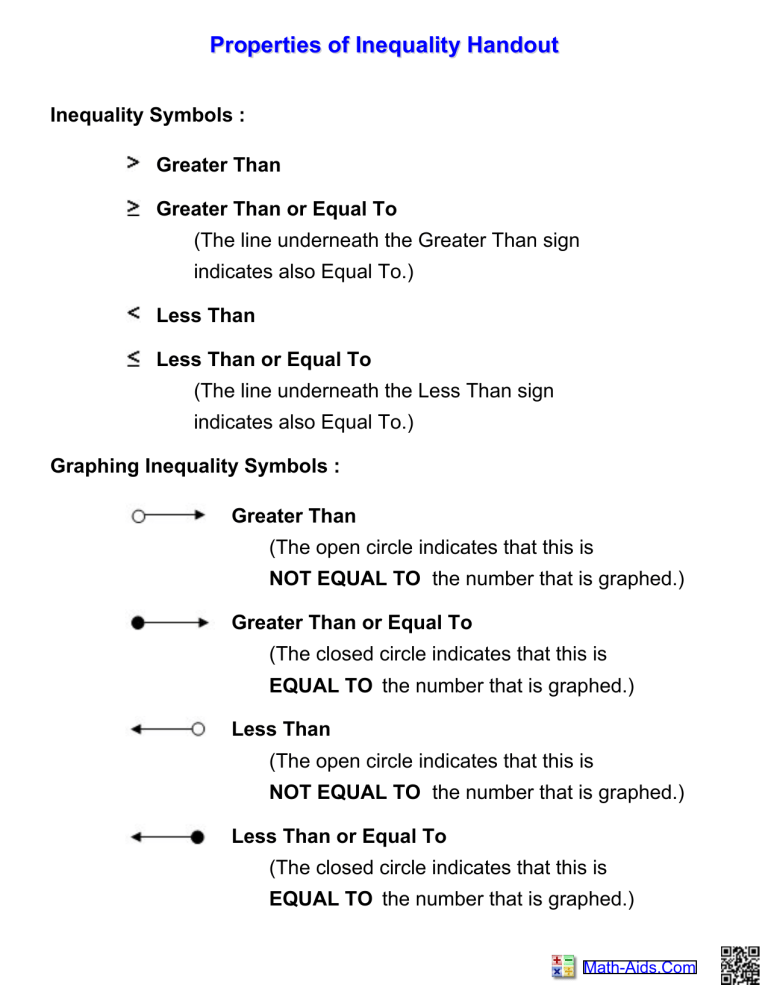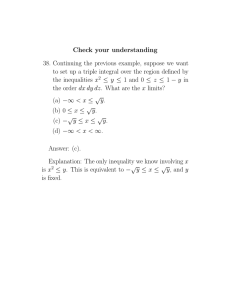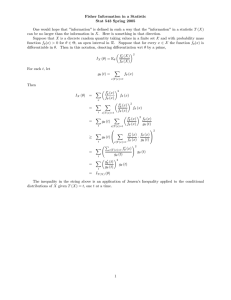
Properties of Inequality Handout Inequality Symbols : Greater Than Greater Than or Equal To (The line underneath the Greater Than sign indicates also Equal To.) Less Than Less Than or Equal To (The line underneath the Less Than sign indicates also Equal To.) Graphing Inequality Symbols : Greater Than (The open circle indicates that this is NOT EQUAL TO the number that is graphed.) Greater Than or Equal To (The closed circle indicates that this is EQUAL TO the number that is graphed.) Less Than (The open circle indicates that this is NOT EQUAL TO the number that is graphed.) Less Than or Equal To (The closed circle indicates that this is EQUAL TO the number that is graphed.) Math-Aids.Com Properties of Inequality Handout Addition Property : If x < y , then x + z < y + z Example : Tom has three dollars and Bill has six dollars. They both earned five dollars for mowing the lawn. Tom still has less money than Bill. $3 < $6 then $3 + $5 < $6 + $5 then $8 < $11 If x > y , then x + z > y + z Example : Jim has ten dollars and Sam has seven dollars. They both earned twenty dollars shoveling snow. Jim still has more money than Sam. $10 > $7 then $10 + $20 > $7 + $20 then $30 > $27 Math-Aids.Com Properties of Inequality Handout Subtraction Property : If x < y , then x - z < y - z Example : Mark has fourteen dollars and Dan has sixteen dollars. They both spent five dollars at the mall. Mark still has less money than Dan. $14 < $16 then $14 - $5 < $16 - $5 then $9 < $11 If x > y , then x - z > y - z Example : Mike has fifteen dollars and Benny has nine dollars. They both spent six dollars at the fair. Mike still has more money than Benny. $15 > $9 then $15 - $6 > $9 - $6 then $9 > $3 Math-Aids.Com Properties of Inequality Handout Multiplication Property : If x < y , and z > 0 then x * z < y * z Example : Suppose 3 < 6 , and z = 10 then 3 * 10 < 6 * 10 or 30 < 60 If x > y , and z > 0 , then x * z > y * z Example : Suppose 20 > 10 , and z = 5 then 20 * 5 > 10 * 5 or 100 > 50 Whenever you multiply by a negative number, you must reverse the inequality sign. If x < y , and z < 0 then x * z > y * z Example : Suppose 2 < 4 , and z = -2 then 2 * -2 > 4 * -2 or -4 > -8 If x > y , and z < 0 , then x * z < y * z Example : Suppose 6 > 3 , and z = -8 then 6 * -8 < 3 * -8 or -48 < -24 Math-Aids.Com Properties of Inequality Handout Division Property : If x < y , and z > 0 then x ÷ z < y ÷ z Example : Suppose 15 < 20 , and z = 5 then 15 ÷ 5 < 20 ÷ 5 or 3 < 4 If x > y , and z > 0 , then x ÷ z > y ÷ z Example : Suppose 20 > 10 , and z = 5 then 20 ÷ 5 > 10 ÷ 5 or 4 > 2 Whenever you divide by a negative number, you must reverse the inequality sign. If x < y , and z < 0 then x ÷ z > y ÷ z Example : Suppose 12 < 24 , and z = -2 then 12 ÷ -2 > 24 ÷ -2 or -6 > -12 If x > y , and z < 0 , then x ÷ z < y ÷ z Example : Suppose 16 > 12 , and z = -4 then 16 ÷ -4 < 12 ÷ -4 or -4 < -3 Math-Aids.Com Properties of Inequality Handout Transitive Property : If x > y and y > z, then x > z Example : Suppose 18 > 9 and 9 > 3 then 18 > 3 If x < y and y < z, then x < z Example : Suppose 4 < 8 and 8 < 15 then 4 < 15 Comparison Property : If x = y + z and z > 0 then x > y Example : Suppose 12 = 7 + 5, then 12 > 7 Math-Aids.Com


